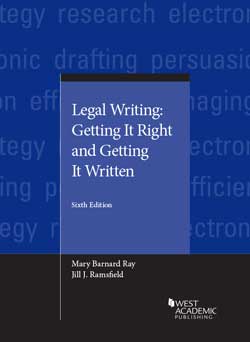- Home
- Legal Writing: Getting It Right and Getting It Written
Legal Writing: Getting It Right and Getting It Written
Designed as a desktop reference for legal writers, the sixth edition of this book adds new entries and updates current entries, provides reference material and guidance on improving one's legal writing, includes a large index with cross-references under each entry, and addresses common questions legal writers have. Covering issues small and large, it offers quick, reliable answers.
New in this edition are entries on specific kinds of writing lawyers must complete, including the following: amicus briefs; pretrial briefs; appellate briefs; reply briefs; scholarly writing; legal recommendations; corporate documents; judicial opinions; PowerPoints; and informative documents, such as fact sheets, white papers, and newsletter articles.
Imprint: West Academic Publishing
Series: Coursebook
Publication Date: 05/16/2018
Mary Barnard Ray, University of Wisconsin Law School
Jill J. Ramsfield, University of Hawaii School of Law
CasebookPlus™
This title is available in our CasebookPlus format. CasebookPlus provides support beyond your classroom lectures and materials by offering additional digital resources to you and your students. Anchored by faculty-authored formative self-assessments keyed to our most popular casebooks, CasebookPlus allows students to test their understanding of core concepts as they are learning them in class – on their own, outside of the classroom, with no extra work on your part. CasebookPlus combines three important elements:
- A new print or digital casebook
- Access to a downloadable eBook with the ability to highlight and add notes
- 12-month access to a digital Learning Library complete with:
- Chapter questions keyed to the casebook
- Black Letter Law questions (available in select subjects)
- Subject area review questions for end of semester use
Leading digital study aids, an outline starter, and audio lectures in select subjects
Students can still utilize CasebookPlus digital resources if they’ve purchased a used book or are renting their text by purchasing the Learning Library at westacademic.com.
With CasebookPlus, you can customize your students’ learning experience and monitor their performance. The quiz editor allows you to create your own custom quiz set, suppress specific quiz questions or quiz sets, and time-release quiz questions. Additionally, the flexible, customized reporting capability helps you evaluate your students’ understanding of the material and can also help your school demonstrate compliance with the new ABA Assessment and Learning Outcomes standards.
What’s New in the Sixth Edition
- Over 100 new entries and cross references including
- usage questions not covered before, such as handling gender terms, using B.C.E. and C.E. , and handling names with titles;
- real-life issues, such as adjusting to a new writing situation, directing others’ work, adjusting levels of formality, multi-tasking, and maintaining grace under fire;
- various documents, such as AMICUS BRIEFS, bench briefs, newsletters, multi-sentence issues, scholarly writing, white papers, law review articles, answers to complaints, pre-trial briefs, legislation, judicial opinions, and the variety of corporate documents that are being created;
- issues related to the electronic age, such as scrubbing electronic documents for security, texting under the table, social media, electronic citations, real-time communications, the limits of spellcheckers, the hazards of using emojis, paperless practice, Powerpoints, and other forms of electronic communications;
- issues related to the shrinking world, such as international communications, English as a second language, English in international situations, global English, and international legal writing; and
- guidelines for handling current work pressures, such as ever increasing time pressure, overwhelming sources of information, document security issues, and social media.
- Expanded content on major topics is now divided into specific entries to make it easier both to see the range of possibilities and to find the specific information needed, including the broader topics of research, reasoning, communication, citation, writing process,
- Expanded information on oral communication, such as oral presentations, voice, and stance.
- Updates in grammar entries on how grammar rules have sometimes changed in practice
- Changes to increase the ease of using the book, including
- updated format modified to make the good examples clearer and the text easier to read and
- a reorganized topical index to facilitate teaching from the book and using the book as a text for self-learning.
Learn more about this series.
Access Denied
Law School Faculty - Sign in or Create an Account to access this content. Law faculty who have created an account can sign in after receiving email notification that registration has been approved. Email accountmanager@westacademic.com or call 800-313-9378 for assistance.
Other Higher Education Faculty who wish to access digital review copies or teaching resources should contact their West Academic Account Manager at college@westacademic.com or 800-360-9378.
Adopters Only
This content is intended for adopters only. Sign in or Create an Account to access this content. Law faculty who have created an account can sign in after receiving email notification that registration has been approved. If you are an adopter who is unable to access this content after signing in, contact your account manager for assistance at accountmanager@westacademic.com or call 800-313-9378 for assistance.
Access Denied
Sign in or Create an Account to access this content. Faculty who have created an account can sign in after receiving email notification that registration has been approved. Contact us for assistance.
Law School Faculty: email accountmanager@westacademic.com or call 800-313-9378.
Other Higher Education Faculty: email college@westacademic.com or 800-360-9378.
Access Denied
Higher education faculty who wish to view this document should contact their West Academic Account Manager at college@westacademic.com or 800-360-9378.
